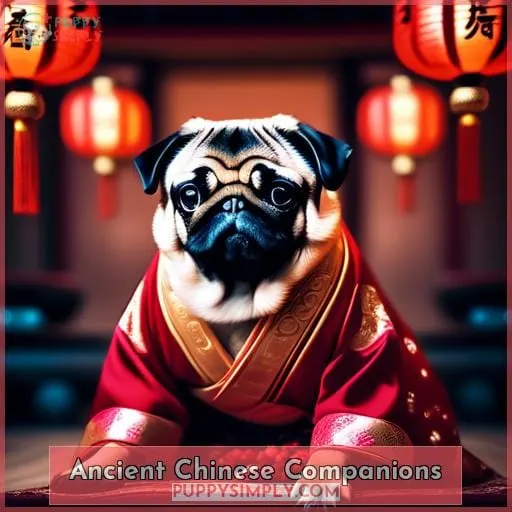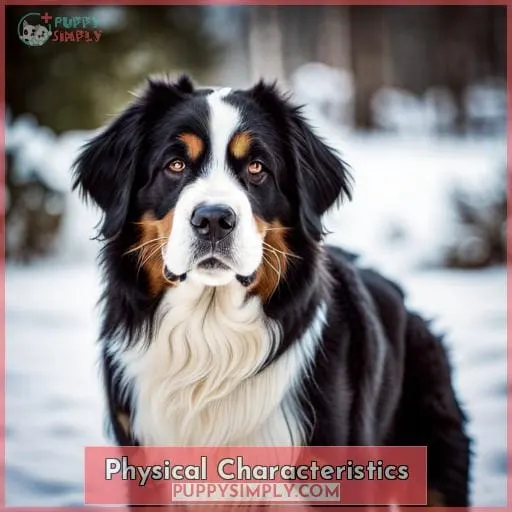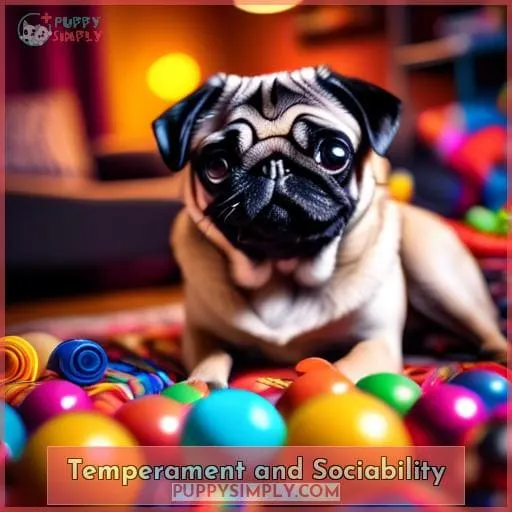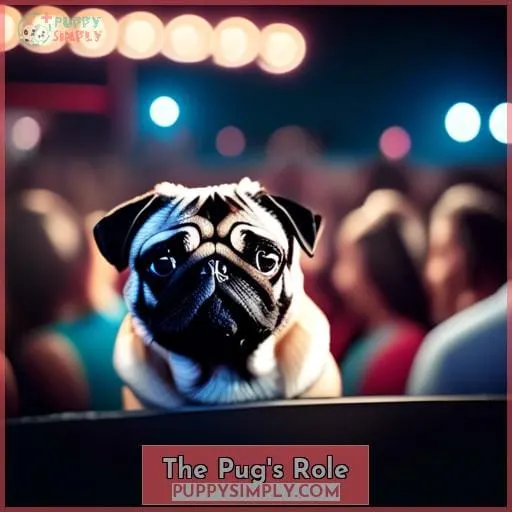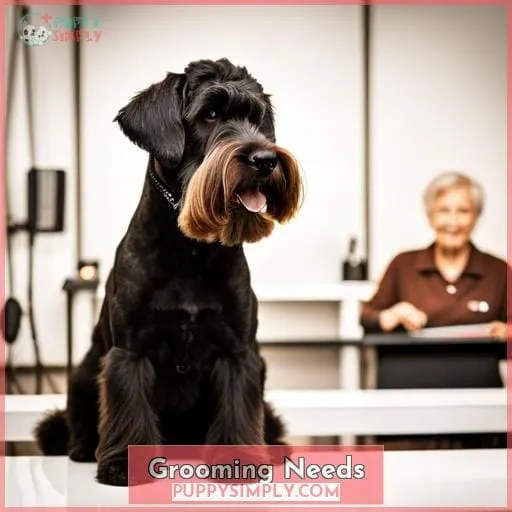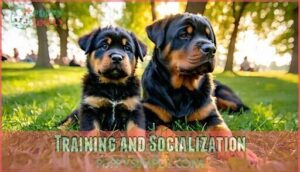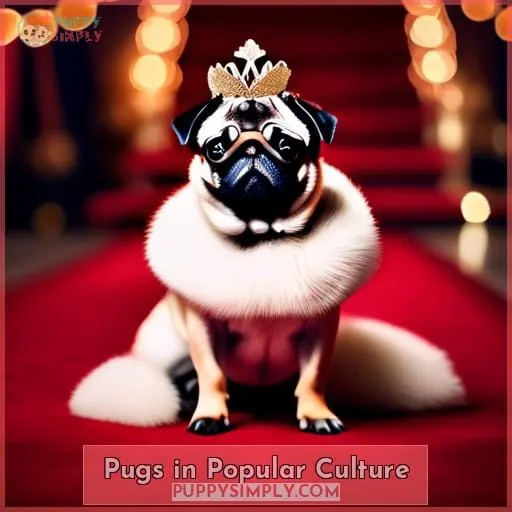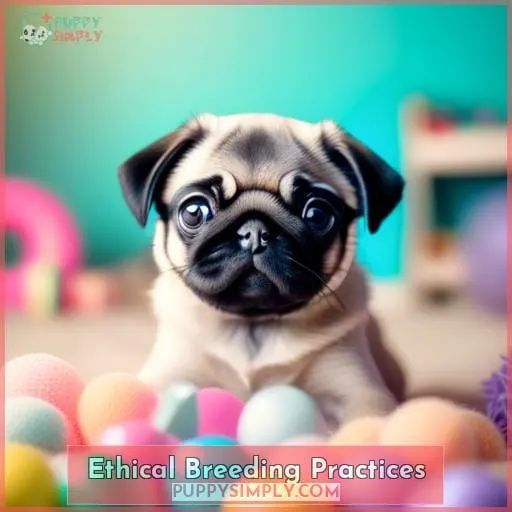This site is supported by our readers. We may earn a commission, at no cost to you, if you purchase through links.
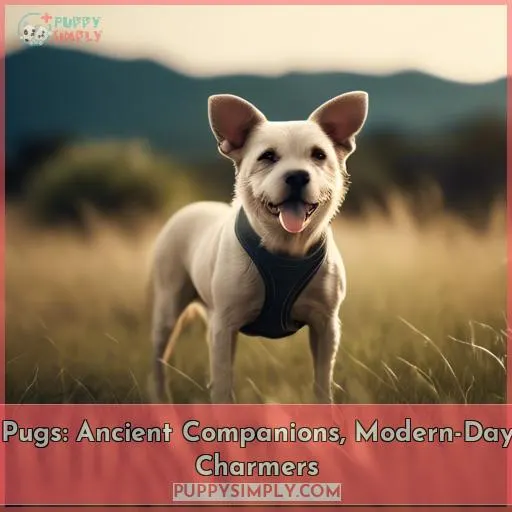 Don’t you wish you could cozy up with the most charming lapdog in the world?
Don’t you wish you could cozy up with the most charming lapdog in the world?
Look no further than the Pug, a breed that’s been bred for centuries to be an ideal companion.
These adorable little dogs are known for their affectionate and playful personalities, making them perfect for families with children and other pets.
Keep reading to learn more about these delightful companions!
Table Of Contents
- Key Takeaways
- Ancient Chinese Companions
- Physical Characteristics
- Temperament and Sociability
- The Pug’s Role
- Health Considerations
- Grooming Needs
- Exercise and Diet
- Training and Socialization
- Pugs in Popular Culture
- Ethical Breeding Practices
- Frequently Asked Questions (FAQs)
- How does the Pug’s unique facial structure contribute to its health problems?
- What are some alternative breeds to Pugs that have a healthier facial structure?
- Why are brachycephalic breeds like Pugs restricted from flying on certain airlines?
- What ethical considerations should breeders keep in mind when breeding Pugs and other brachycephalic breeds?
- What are some things potential Pug owners can do to minimize the risk of health problems in their dogs?
- Conclusion
Key Takeaways
- Pugs were originally bred in ancient China as companion dogs for emperors and nobles.
- They were brought to Europe and gained popularity among the elite as symbols of status and wealth.
- Pugs have a compact stature, short, smooth coats, and distinctive wrinkled faces.
- They are affectionate, loyal, and playful, making them excellent companions for families.
Ancient Chinese Companions
You’re about to learn how Pugs became treasured companions of Chinese emperors.
We’ll discuss how these dogs made their way from ancient China to Europe, captivating hearts along the way.
Origins in China
Tracing their roots back to ancient China, Pugs were cherished companion dogs, adored by emperors and nobles alike.
Their influence on Chinese culture is undeniable, with their image gracing artifacts and artwork, symbolizing prosperity and good fortune.
Over the centuries, these charming creatures embarked on a remarkable journey, captivating hearts across the globe, leaving an indelible mark on history.
Their evolutionary changes, shaped by both natural selection and human intervention, have resulted in the unique and endearing breed we know today.
Emperors’ Treasured Pets
Pugs thrived in China’s imperial palaces, cherished by emperors as loyal and affectionate companions.
They were symbols of status and power, pampered in the royal courts, and often depicted in art and literature.
Pugs’ presence in the imperial palaces elevated their cultural significance, making them symbols of wealth, nobility, and imperial grandeur.
Spread to Europe
Once you brought Pugs to Europe, they swiftly gained popularity among the continent’s elite.
Their charm, playful nature, and compact size made them ideal companions for royalty and nobles.
Aristocrats adored Pugs as symbols of status and wealth.
Artists immortalized their endearing features in paintings and sculptures.
Their presence in European courts influenced fashion, art, and literature.
The Pug breed became a symbol of luxury and refinement, deeply ingrained in European culture.
Their economic impact was significant, boosting demand for Pug-related goods and services.
Physical Characteristics
Beyond their wrinkled faces, Pugs have compact statures, measuring 10 to 14 inches tall and weighing between 18 and 30 pounds.
Their short, smooth coats come in a variety of colors, including fawn, black, and apricot, adding to their distinctive charm.
Wrinkled Faces
With their distinctive and charming wrinkles, Pugs stand out as a unique breed among canine companions.
These facial expressions, etched with centuries of history, hold cultural significance and reflect the breed’s evolutionary journey.
While the wrinkles add to their undeniable charm, they also present health implications that responsible breeders must address.
Understanding the delicate balance between preserving the Pug’s unique features and ensuring their well-being is crucial for the ethical continuation of this beloved breed.
Compact Stature
In addition to their distinctive wrinkled faces, Pugs possess a sturdy, compact stature that adds to their appeal as charming companions. Their small size, typically ranging from 10 to 14 inches in height and 18 to 30 pounds in weight, makes them well-suited for apartment living or homes with limited space.
While their compact build can be beneficial, it also presents unique considerations, such as potential breathing problems due to their shortened face and the need for regular shedding management.
Despite these challenges, Pugs’ compact stature and playful nature make them beloved companions for people of all ages and lifestyles.
- Their small size makes them ideal for cuddling and carrying, which fosters a sense of closeness and affection.
- Their playful antics and comical expressions can bring laughter and joy to any household, creating a lively and entertaining atmosphere.
- Their compact stature allows them to adapt to various living situations, making them suitable for both spacious homes and cozy apartments, promoting a sense of belonging and comfort.
Distinctive Coat Colors
You’ll often find Pugs in a variety of coat colors, including fawn, black, and apricot, adding to their distinctive charm and appeal.
This color diversity stems from coat color genetics, influenced by dominant and recessive genes.
Whether fawn, black, or apricot, each Pug’s coat color is a unique expression of their genetic heritage.
Temperament and Sociability
Your Pugs’ affectionate and loyal nature, coupled with their playful and humorous demeanor, makes them a delightful addition to any family.
Their amiable disposition extends to children and other pets, making them exceptional companions for households of all types.
Affectionate and Loyal
Surrounded by your loved ones, you’ll find Pugs curled up on laps, eager to shower affection and loyalty.
Their eyes sparkle with adoration as they gaze upon their humans, tails wagging in rhythm with their joyful hearts.
Pugs form deep emotional attachments, fiercely protective of their families.
They assess loyalty through bonding behaviors, seeking out those who reciprocate their love and affection.
Their trustworthiness is unwavering, making them exceptional companions, always by your side, offering unwavering support and boundless love.
Playful and Humorous
Their joyful spirit and mischievous nature will keep you entertained and laughing.
Pugs excel at comedy antics, turning everyday moments into hilarious hijinks.
From playful pranks to amusing escapades, they’ll fill your days with laughter.
Their jovial frolics will lighten your mood, making them the perfect companions for those seeking a humorous and lighthearted addition to their family.
Good With Children and Pets
With their friendly and gentle nature, you’ll find Pugs make wonderful companions for both children and other pets.
Their playful and affectionate personality shines through, bringing joy and laughter to families.
Whether it’s a game of fetch in the park or a cuddle on the couch, Pugs excel at creating harmonious interspecies relationships.
Their patient and tolerant demeanor makes them ideal playmates for children, while their eagerness to please ensures they’ll get along swimmingly with other pets, becoming cherished members of your loving household.
The Pug’s Role
You’ll uncover the Pug’s multifaceted role throughout history:
- From being cherished companions to emperors
- To gracing the homes of modern-day celebrities
- As symbols of status and beloved family members
The breed’s charm and loyalty have made it a favorite among people of all walks of life.
Companion Dogs
As loyal companions, Pugs have been by people’s sides for centuries, offering unwavering affection and endless entertainment.
Their ancient origins in China and cultural significance as symbols of status have made them beloved by emperors, royals, and modern celebrities alike.
Pugs have historically served as companions, providing comfort and joy to their owners.
Their ability to adapt to various lifestyles has ensured their popularity in the modern world.
Symbols of Status
During your stroll through time, you’ll find Pugs often nestled in the palaces of royalty and the lap of luxury.
They were more than cherished pets; they were status symbols.
Noble companion dogs, they adorned the courts of emperors and queens, adding a touch of charm and prestige.
Pugs’ distinctive appearance and playful demeanor made them the epitome of elegance and refinement.
Chinese emperors treasured Pugs as symbols of imperial power.
European monarchs adored them as emblems of nobility.
Even the Order of the Pug, a secret society, chose the Pug as their symbol of loyalty.
These tiny ambassadors of affection continue to captivate hearts, leaving an indelible mark on history and pop culture.
Modern-Day Celebrities’ Choice
- Pugs have charmed celebrities like Rob Zombie, Valentino, and Queen Victoria, who were devoted owners.
- Today, Pugs continue their reign in pop culture, captivating stars like Gerard Butler, Jessica Alba, Hugh Laurie, Tori Speling, and Paris Hilton.
- This enduring legacy speaks to the Pug’s unique charm, earning them a place in the hearts of the famous and ordinary alike.
- Celebrity Pug Owners and Their Notable Pugs:
- Hugh Laurie: Arnold
- Jessica Alba: Sid
- Gerard Butler: Lolita
- Tori Speling: Mimi LaRue
- Paris Hilton: Tinkerbell
Health Considerations
As a Pug owner, you should be aware of certain health considerations associated with the breed:
- Brachycephalic syndrome, which can cause breathing difficulties.
- Eye conditions like corneal ulcers.
- Obesity risks due to their tendency to overeat.
Brachycephalic Syndrome
When it comes to Pugs, you’ll need to be aware of Brachycephalic Syndrome, a condition that hinders their breathing due to their flat faces.
This issue stems from selective breeding, prioritizing aesthetics over health.
While genetic engineering offers a glimmer of hope, alternative breeds like Retromops aim to restore Pugs’ healthier facial structure.
Join the movement advocating for breed standard changes that prioritize animal welfare.
The Pug’s charm shouldn’t come at the cost of its well-being.
Eye Conditions
Eye conditions, a risk associated with Pugs’ prominent eyes, demand your vigilance in maintaining their ocular health.
Tear stains, a common issue, can be managed with proper cleaning and diet.
Dry eye syndrome, leading to discomfort, requires veterinary attention.
Cherry eye, a protrusion of the tear gland, may need surgical correction.
Eyelid fold dermatitis, affecting the skin around the eyes, necessitates regular cleaning.
With your care, your Pug’s captivating peepers will continue to charm the world.
Obesity Risks
Just like with eye conditions, Pugs are prone to obesity.
You’ll need to carefully manage their diet and ensure regular exercise to maintain a healthy weight.
While Pugs are food enthusiasts, overfeeding and homemade diets high in calories can contribute to weight gain.
Obesity strains their joints, leading to mobility issues and arthritis.
To prevent this, stick to breed standards and consult your vet for a Pug diet plan that balances their nutritional needs with their exercise level.
Grooming Needs
To keep your Pug’s coat shiny and healthy:
- Brush it regularly to remove dead hair and prevent mats.
You’ll also need to:
- Clean their eyes and ears regularly to prevent infection.
- Trim their nails as needed.
Regular Brushing
To keep your Pug’s coat healthy and free of mats, regular brushing is a must.
All types of Pug hair, whether short, smooth, or wiry, benefit from routine brushing. It not only removes dead hair and prevents tangles but also helps distribute natural oils, giving their coat a lustrous shine.
Start desensitizing your Pug to brushing from an early age, making it a positive experience.
Eye and Ear Care
Next, regularly inspect and clean your Pug’s eyes and ears to prevent infections and maintain their overall health.
- Gently wipe away any discharge or debris from the corners of their eyes using a soft, damp cloth.
- Trim the hair around their eyes to prevent it from irritating them.
- Clean their ears with a cotton ball or soft cloth moistened with a gentle ear cleaner.
This grooming routine will help keep your Pug’s eyes and ears healthy and free from infection.
Managing Shedding
Regularly brushing your Pug’s coat will minimize shedding and keep their fur looking its best.
This not only reduces allergy triggers in your home but also cuts down on vacuuming.
Invest in quality brushes designed for short-coated breeds, and consider deshedding shampoos for bath time.
Professional grooming every 4-6 weeks can also help manage shedding and keep your Pug looking sharp.
Exercise and Diet
You’ll need to balance your Pug’s moderate exercise requirements with a controlled diet to prevent obesity, a common problem among this breed.
Daily walks and engaging playtime will keep your Pug active and healthy.
Moderate Exercise Requirements
Your Pug’s moderate exercise needs keep them fit and healthy.
Aim for daily walks or playtime in a safe, enclosed area.
Moderate exercise prevents obesity, a common issue in Pugs.
Consider indoor activities like fetch or puzzle toys on rainy days or when apartment living limits outdoor time.
Pugs may face travel restrictions due to their breathing challenges.
Consider ethical breeding practices that prioritize genetic diversity and healthier facial structures.
Embrace the historical significance of Pugs as symbols of loyalty and charm.
Diet Control to Prevent Obesity
To keep your pug trim and prevent weight gain:
- Mind their diet, ensuring you don’t overfeed them.
- A pug’s ideal weight depends on their size and frame, but generally, they should weigh between 14 and 18 pounds.
- Feed them a high-quality diet rich in protein and low in fillers.
- Avoid giving them table scraps or excessive treats.
- Instead, opt for healthy treat options like fruits, vegetables, or specially formulated dog treats.
- You can also explore homemade dog food recipes tailored to your pug’s needs.
Regular exercise is crucial for maintaining a healthy weight:
- Engage your pug in friendly activities like walks, fetch, or swimming.
- Joint health supplements can also be beneficial in supporting their mobility and overall well-being.
Training and Socialization
While Pugs are intelligent and eager to please, they also have a willful side.
Early socialization and consistent training are essential.
Gentle, positive reinforcement techniques help them learn good behaviors and avoid developing bad habits.
Intelligence and Willfulness
Pugs’ intelligence and willfulness demand consistent training and early socialization.
Their cleverness makes them quick learners, but their stubborn streak requires patience and positive reinforcement.
Training techniques that reward good behavior and discourage bad habits are key.
Mental stimulation through interactive toys and games keeps their sharp minds engaged and prevents boredom-induced naughtiness.
Housebreaking can be a challenge, so establish a routine and use crate training if needed.
Separation anxiety is common, so accustom your Pug to spending time alone gradually.
Socialization from puppyhood is crucial to prevent shyness or aggression.
Expose your Pug to various people, animals, and environments to create a well-rounded and confident companion.
Importance of Early Socialization
Starting early, socializing your Pug puppy with people, animals, and different environments helps prevent behavioral issues and fosters a well-rounded, friendly demeanor.
Introduce your Pug puppy to new experiences, people, and animals gradually, using positive reinforcement and rewards to create positive associations.
Early socialization helps prevent separation anxiety, fear, and aggression, leading to a happier, more balanced dog.
Pug puppies are eager to please and learn, making training a breeze.
Use positive reinforcement techniques, such as treats, praise, and play, to teach basic obedience commands and tricks.
Consistency and patience are key to successful Pug training.
Pugs in Popular Culture
Pugs have found their way into our hearts and homes.
They’ve also graced the pages of literature and starred in paintings by renowned artists.
Even royalty and celebrities have fallen for their charm, making Pugs true pop culture icons.
Featured in Art and Literature
Because they’re so charming, Pugs have been the subject of art and literature for centuries, appearing in paintings, books, and even movies.
From Goya to Hogarth to Reinagle, renowned European artists captured their unique charm on canvas.
Literary giants like Harriet Beecher Stowe and Alexandre Dumas featured them in their works, immortalizing their endearing personalities.
In the modern era, celebrities like Queen Victoria, Valentino, and Rob Zombie have proudly owned Pugs, further solidifying their place in popular culture.
These artistic and literary depictions showcase the Pug’s enduring cultural significance, transcending time and captivating hearts worldwide.
Royal and Celebrity Owners
Join the ranks of royalty and celebrities who have cherished Pugs as beloved companions throughout history.
From Queen Victoria to Prince William of Orange, Pugs have found a place in the hearts of the elite.
In Hollywood, stars like Rob Zombie and Valentino have been smitten with these charming dogs.
Their unique appearance and delightful personalities have captured the fancy of many, leading to a vast collection of Pug memorabilia and a dedicated fan base.
These furry ambassadors have left an indelible mark on popular culture, cementing their status as cultural icons.
Ethical Breeding Practices
You can help ensure the well-being of Pugs by supporting breeders who prioritize their health and well-being over aesthetics. Responsible breeders take measures to preserve the breed’s heritage while minimizing health risks.
Genetic Diversity:
Encourage breeders to maintain a diverse gene pool to reduce the risk of inheritable health conditions.
Breeding Standards:
Advocate for breeding standards that prioritize health and temperament over extreme physical characteristics.
Crossbreeding:
Consider crossbreeding Pugs with other breeds to introduce genetic diversity and improve overall health.
Responsible Ownership:
Educate yourself about the breed’s health needs and provide your Pug with the care it deserves.
By supporting ethical breeding practices, you contribute to the preservation of this cherished breed while ensuring the happiness and well-being of individual Pugs. Their unique charm and unwavering loyalty make them treasured companions, and responsible ownership practices ensure their continued presence in our lives.
Frequently Asked Questions (FAQs)
How does the Pug’s unique facial structure contribute to its health problems?
Your pug’s smooshed face, though adorable, can cause:
- Breathing difficulties
- Eye irritation
- Skin fold infections
It’s a package of cuteness with a side of health concerns.
What are some alternative breeds to Pugs that have a healthier facial structure?
For a healthier Pug alternative, consider the Retromop, a crossbreed with a longer snout and improved breathing.
Why are brachycephalic breeds like Pugs restricted from flying on certain airlines?
When it comes to flying, brachycephalic breeds like Pugs face restrictions.
Due to their flat faces, brachycephalic breeds can experience breathing difficulties and overheating.
Airlines prioritize the safety and well-being of all animals on board.
What ethical considerations should breeders keep in mind when breeding Pugs and other brachycephalic breeds?
As a breeder, you must grapple with the ethical dilemma: prioritize breed standards or animal welfare?
Consider the consequences of perpetuating health issues for the sake of aesthetics.
What are some things potential Pug owners can do to minimize the risk of health problems in their dogs?
To minimize health risks in your Pug:
- Maintain a healthy weight.
- Avoid extreme temperatures.
- Clean facial folds regularly.
- Schedule regular checkups with your veterinarian.
Conclusion
What are pugs bred for?
Companionship.
They’ve spent centuries earning their place on laps and in hearts.
Delightfully affectionate and playful, pugs make ideal family pets.
Their compact size and moderate exercise needs make them suitable for various living situations.
While they may have some health concerns, responsible breeding and proper care can help ensure these charmers remain happy and healthy.
If you’re seeking a loving and entertaining companion, a pug may be the perfect match.

